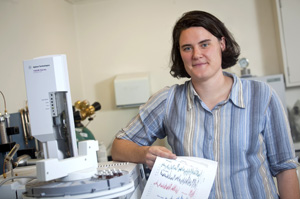How will global climate change if human activities continue to release large quantities of greenhouse gases such as carbon dioxide into the atmosphere? Understanding past changes in climate and surface ocean temperatures can help scientists better predict future changes in climate.
Kira Lawrence, assistant professor of geology and environmental geosciences, is a paleo-climatologist, someone who studies earth’s past climate changes as recorded in the geologic record to learn how and why climate has changed over time.

Kira Lawrence
“Past climate conditions can give us perspective on modern climate change,” says Lawrence. “The early part of the Pliocene epoch, about 3-5 million years ago, is one of the best analogs for future climate conditions. The present concentration of carbon dioxide in earth’s atmosphere (about 380 parts per million), was last reached during the early Pliocene and global average temperatures during the early Pliocene were 3 degrees Celsius warmer than today, consistent with projections for Earth’s surface temperature in 2100.”
Lawrence is part of a research team whose results are featured in the June 18 issue of the journal Science. She and her collaborators from Brown University, Luther College in Iowa, and the University of Hong Kong analyzed ocean floor sediments from the last 3.5 million years taken from four locations in tropical oceans: the eastern equatorial Atlantic, the South China Sea, the eastern equatorial Pacific, and the Arabian Sea.
Despite the global geographic spread of the sites, the samples show remarkable uniformity in temperature changes over the last 2.7 million years, corresponding to the most recent periods of massive glacial advances and retreats thousands of miles away in the polar regions. Fluctuations in these tropical temperature records also matched a transition in the length of ice age cycles from 40,000 to 100,000 year intervals during the same 2.7 million year interval.
“Since the temperature changes in the tropical core samples we studied preceded glacial advances and retreats and were consistent at all of our sites, we believe that another mechanism played an important role in forcing global climate change since 2.7 million years ago, likely the atmospheric greenhouse gas, carbon dioxide,” says Lawrence.
Abundant evidence from the geologic record shows that carbon dioxide levels in the atmosphere affected ancient climates. Most notably, air bubbles trapped in ice core samples obtained from the Antarctic ice cap document changes in the composition of the atmosphere over the last 800,000 years. These Antarctic ice core records show that carbon dioxide levels in the atmosphere declined during each of the last seven ice ages, implying that the decline of carbon dioxide in the atmosphere is connected to global cooling.
“We believe atmospheric carbon dioxide played a significant role in magnifying past global temperature variations caused by periodic changes in the position of the earth in its orbit around the sun,” says Lawrence.
She reconstructs sea surface temperature changes over the last 5 million years to understand the evolution of climate during that time. This period witnessed the last major climate transition in Earth history, a shift from warmer temperatures and a nearly ice-free Northern Hemisphere to a colder interval in which the rapid expansion of large ice sheet occurred across northern landmasses.
“Ocean sediments have preserved a fairly continuous record of past ocean temperature variations,” she continues. “The geologic record allows us to explore past changes in climate and some of the fundamental relationships that exist within the climate system, such as how changes in ocean and atmospheric circulation or atmospheric greenhouse gas concentrations can impact the climate.”
“Understanding how changes in atmospheric carbon dioxide concentrations affect ocean surface temperatures is an important element of understanding future climate change,” she adds.
Lawrence studies lipid compounds (fat molecules) produced by a few species of ocean surface-dwelling algae. The algae produce lipids in a way that is sensitive to temperature. When these organisms die and their remains settle to the seafloor, their lipid compounds are buried within layers of sediment that ultimately preserve these molecules. Lawrence and other paleoclimatologists collect and analyze ocean sediments using these and other chemical and biological signatures preserved within them to generate records of past climate conditions. In this way, Lawrence constructs long records of changes in surface ocean temperature over time.
She has also studied ocean sediment samples to determine sea surface temperatures at sites in the North Atlantic, Bering Sea, and Pacific. She was the lead author of an article in Science (2006) which reconstructed past surface temperature variations in the eastern tropical Pacific Ocean and lead author of an article in Paleoceanography (2009) exploring past changes in North Atlantic Ocean surface temperatures. She also has been a co-author of four other articles in the last year in Science, Paleoceanography, and Earth and Planetary Science Letters.
